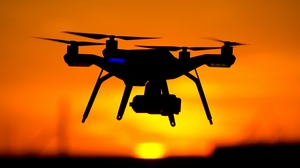GEOPOLITICS: Military Drones: Geopolitical Toys Or The Replacement For Boots On The Ground?
By Jason Woodroofe – OWP via GEO PR Channel
European News & Media Centre Malaga
Google Indexed at 08:44 on 220620
When one thinks of drones, images of an American MQ-9 Reaper drone flying over somewhere in the Middle East are often the first to appear in one’s mind. The reality is that the global market for defence drones is far wider-reaching. Last week I wrote about the Trump administration’s push to redesign its policy stance on the
Missile Technology Control Regime (MTCR) in order to push U.S. drones to new customers.
The U.S. government is making this change to keep its defence industry competitive in a drone market increasingly flooded with foreign drones. Not just Unmanned Aerial Vehicles (UAVs) either, but unmanned tanks, submarines and robotics weapons are all becoming increasingly popular alternatives to sending soldiers into combat. In fact, according to a recent analysis by
CSIS, land robots are being increasingly used by militaries for tasks such as firefighting, transportation, search and rescue, engineering and even combat. Is a new era of warfare on the horizon?
Money Talks
One of the clearest indications that drone defence technology is on the way to becoming an everyday reality in war is the amount of money pouring into the industry. The financial analysis website
MarketsandMarkets estimates that the market for military robots is projected to grow from $16.79 billion U.S. in 2017, to $30.83 billion by 2022. Defence and aerospace analysis firm Teal Group estimates that worldwide research-and-development spending on UAV drones alone to rise from a projected $11.1 billion in 2020 to $14.3 billion by 2029 — nearly a 30 per cent increase. Financial giant Goldman Sachs goes further and estimates that wider drone-related technologies have already reached a total market size of approximately $60 billion between 2016 and 2020.
Not all of this growth is from the U.S. companies such as
Lockheed Martin,
General Atomics and
Northrop Grumman either. While these companies and other U.S. competitors initially dominated the drone market over the last two decades, newcomers from countries such as China, Israel, and India are starting to push into the market. Europe and the Asia-Pacific are the two drone markets expected to grow the most over the next decade according to MarketsandMarkets. Newcomers to the drone market, such as Turkish company
Baykar Defence, are already making waves, with their drones being deployed with striking success in the Libyan conflict.
Drone Dominance?
In Libya, so many drones have been deployed that UN special representative to Libya
Ghassan Salame called it the “largest drone war in the world,” Al Jazeera news reports. While Chinese
Wing Loong drones initially helped the LNA capture ground in the conflict, once Turkish Baykar drones were supplied to the UN-backed GNA, the tide has quickly turned the other way. The UN reports that over 1000 drone strikes have been conducted since UAVs appeared in the conflict in 2016.
In 2016, the U.S. Navy launched the first of its new unmanned surface vehicles (USVs) as a part of an anti -submarine warfare program. “Sea Hunter,” the first completed USV of the project, is essentially a full-size unmanned warship, specifically designed to hunt submarines, reports CNBC. Seahunter cost approximately $35.5 million USD to construct but is expected to save as much as 30% in maintenance costs over 10 years due to being crewless.
In Syria, unmanned robotics have been making moves on the ground as well. Russia has been battle testing it’s new Uran-9 robotic tank. However, the Uran-9 has reportedly been having widespread issues. Business Insider reported that the tank had issues maintaining its connection with the operator around buildings and firing its gun, as well as a range of other problems.
Despite setbacks, it is easy to see the speed at which the drone and robotics industry has cemented its place on the modern battlefield, with drones already well integrated into warfare for roles such as surveillance and bomb disposal. Additionally, As drones are creating new spaces for warfare and geopolitical competition, a rush has begun to create cheaper and more cost-effective options. A market that was once dominated by the U.S. is now expanding as new companies and countries construct cheaper drone parts.
Cheap as Chips?
While the idea of armed drones and the U.S. military were once synonymous, the U.S. is arguably being squeezed out of markets by new competitors. To construct the iconic MQ-9 Reaper it costs approximately US$15.9 million, according to Defence News. When we compare that price to the Wing Long ii drone made in China that costs a mere estimated U.S. one to two million, it is easy to see market competition occurring. China has been increasingly willing to push into markets that the U.S. has in the past been unwilling to touch due to concerns such as human rights abuses. However, the Trump administration’s approach to drone sales is rapidly changing.
The Stockholm International Peace Research Institute, an NGO which tracks international arms sales, claims that U.S. drone maker General Atomics sold just 15 MQ-9s to other countries between 2008 and 2018. For comparison, China sold 163 large armed drones to 13 countries and Israel exported 167 units during the same period.
In short, drones are getting cheaper because we are getting more efficient at building them and because the drone manufacturing industry is growing rapidly. While the U.S. once had market dominance of the industry and could charge a premium for the technology, China is proving drones can be literally as cheap as the chips they’re built from.
However, when all modern drones and unmanned systems still fail to rival the likes of manned fighter aircraft, tanks and ships in terms of speed, armaments and range, why are we rushing to build more?
Why send a drone instead of a person?
The immediate answer to this question is that there’s no risk to life or limb by sending a robot into battle in the place of a soldier. However, this is just one of the many reasons that decision-makers favour drones and robotics in warfare. Let’s take the recent U.S.-Iranian tensions as an example.
On June 20, 2019, the
BBC reported that the U.S. military confirmed Iran’s Islamic Revolutionary Guard Corps had shot down a United States RQ-4A Global Hawk surveillance drone over the strait of Hormuz. Iran claimed the drone was in its airspace while the U.S. denied this and claimed it in international airspace, the usual story. While tensions remained high, the incident did not immediately escalate further as it might have if, say, Iran had killed or captured a U.S. pilot. The U.S. arguably has less political accountability or connection to a drone than a U.S. soldier. This is a doctrine the U.S. has been following for decades now in its drone war on terror, especially in countries the U.S. technically or legally shouldn’t be operating in. As politicians face increasing pressure at home to end foreign conflicts and the possible stream of body bags they could create, the robotic replacement looks increasingly favourable.
But is it really that smart?
Are drones really all they’re made out to be in both modernising the battlefield and saving soldiers lives? The short answer is no, and the longer answer is also no. Even as drones become cheaper, only a select club of rich countries remain eager and able to buy them. While drones lower the risk of losing soldiers in conflict, in doing so they then raise the potential benefits of engaging in conflict for decision-makers. If politicians can send drones to do the dirty work of what previously required soldiers, in an arguably less accountable way, why wouldn’t they? And this is the crux of the issue. Drones arguably encourage richer countries to engage in foreign warfare away from their borders. This, in turn, desensitises politicians to violence and the significance of resorting to violence in international relations. If no body bags come home, then the public doesn’t see the problem first-hand and won’t hold decision-makers accountable. Yet we forget that on the other end of the
situation are civilians and homes and cities left to the mercy of drone technology.
The U.S. war on terror is a prime example of the desensitization to drone violence. How many times in the past decades have we seen reports of civilian casualties in drone strikes, and yet the market keeps expanding. While drones and robotic technology do have a real potential to benefit the world, is warfare where that is going to happen? At the end of the day, we need to ask whose lives are we saving by replacing the pilot in the plane with a computer?
About Author
Jason Woodroofe – Communications Advisor at Volunteer Service Abroad/ The Asia Foundation is a recent BA graduate student who majored in Politics and Security Studies at Massey University. He is particularly interested in non-traditional security issues, human security and foreign policy among other topics. Until recently he was working as a volunteer communications advisor and researcher in Timor-Leste looking at local security and community policing.
About
The Organization for World Peace – [OWP] The Organization for World Peace (OWP) targets key issues such as war and international security with the aim of educating and challenging individuals as well as larger international institutions to think critically about peaceful solutions to complex issues plaguing society. The OWP aims to challenge the status quo of resorting to war and destruction both within the national and international space. Instead, the OWP proposes peaceful solutions to these complex issues. The OWP aims to restore the lives of individuals and families affected by conflict by helping them rebuild their lives and helping them reintegrate back into society. This way, victims of war such as internally displaced persons and former child soldiers have a chance to break out of the perpetual cycle of violence.
https://theowp.org/reports/military-drones-geopolitical-toys-or-the-replacement
-for-boots-on-the-ground/









